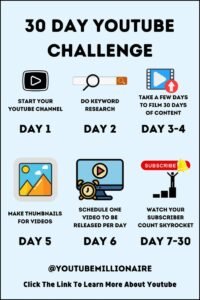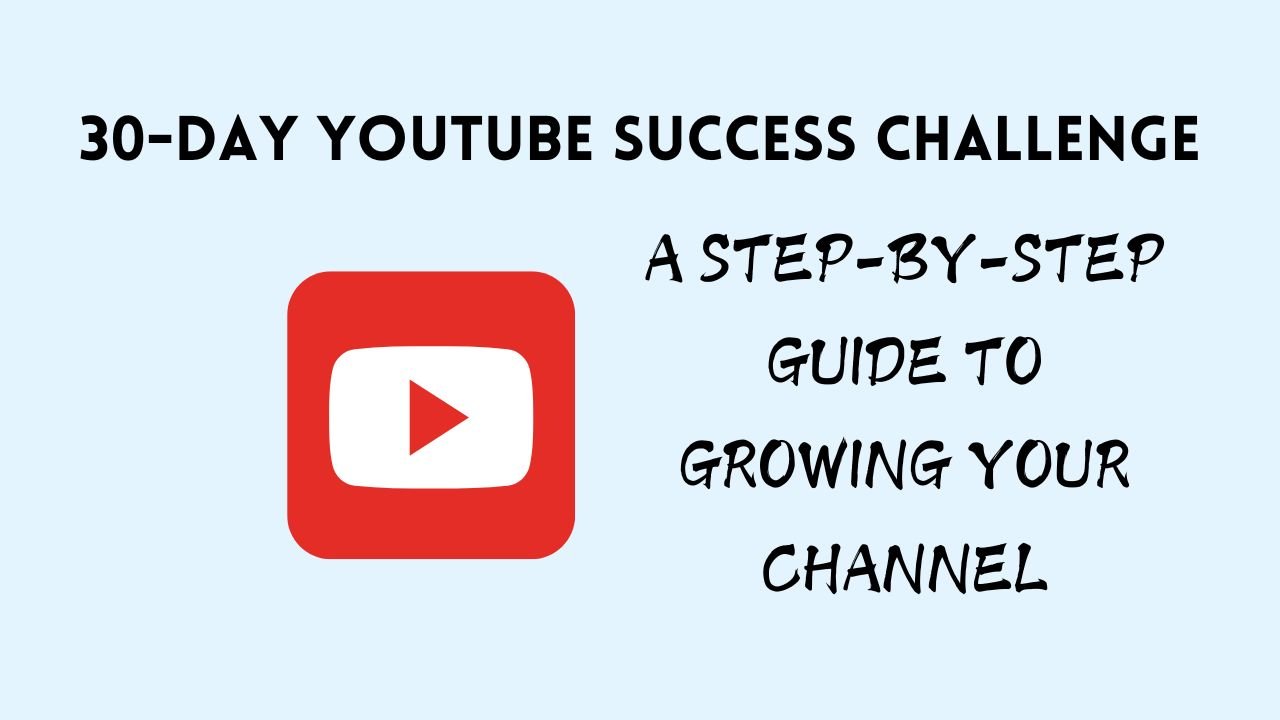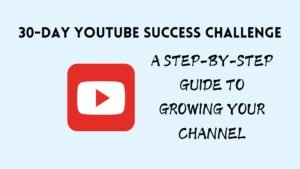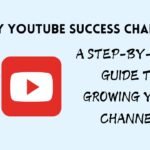30-Day YouTube Success Challenge: A Step-by-Step Guide to Growing Your Channel
If you’ve ever dreamed of becoming a successful YouTuber, the road to success can feel overwhelming. With millions of channels out there, it might seem impossible to stand out and grow a dedicated audience.

However, with a clear and structured plan, achieving YouTube success is not only possible but can also be incredibly rewarding.
To help you get started, I’ve designed a 30-day YouTube Success Challenge.
In this challenge, we will cover everything from starting your YouTube channel to creating content, optimizing it, and analyzing your performance.
By the end of this month-long challenge, you will have a fully functional YouTube channel with 30 videos published and scheduled, along with a solid strategy for continued growth.
Let’s dive into the details of this challenge and break down the steps you’ll take each day to succeed!
Day 1: Starting and Creating Your YouTube Channel
Before you can make money on YouTube or build an audience, you need to have a channel.
On Day 1, we will focus on setting up your YouTube channel and ensuring it is ready for success.
Here’s a step-by-step guide to setting up your YouTube channel:
- Sign in to Google: If you don’t already have a Google account, create one. You’ll need it to sign in to YouTube.
- Create Your Channel: Once you’re signed in, go to YouTube and click on the profile icon at the top right. Choose “Your Channel,” and follow the instructions to create a new channel. Choose a name that reflects your niche and brand.
- Customize Your Channel: Add a profile picture and channel banner. Make sure your design reflects the vibe of your niche. If you’re unsure about design, use online tools like Canva to create free and professional-looking graphics.
- Write Your Channel Description: This is where you’ll tell your audience what your channel is about and what kind of content they can expect. Be clear and concise, including relevant keywords (like your niche) to improve discoverability.
- Add Channel Links: Include links to your website or social media profiles to help viewers connect with you outside of YouTube.
- Your channel is now ready to go! Having a well-designed and clearly defined channel is crucial for attracting your ideal audience.
Day 2: Topic/Niche Research and Keyword Research
On Day 2, we will dive into niche research and keyword strategy. Choosing the right niche and understanding your target audience is one of the most important steps in achieving YouTube success.
Choosing Your Niche
The first step in YouTube’s success is selecting a niche. You need a topic that both excites you and has a dedicated audience. To pick the right niche:
- Consider Your Passions and Expertise: What are you truly passionate about? What are you good at? Choosing a niche that aligns with your interests ensures you’ll stay motivated to create content over the long term.
- Market Demand: Check if there is an active audience for your niche. Use tools like Google Trends and YouTube search to identify popular topics and keywords.
- Avoid Overcrowded Niches: While high-demand niches like “tech reviews” or “beauty tutorials” can be profitable, they also have intense competition. Finding a smaller, underserved niche can give you a competitive edge.
Keyword Research
Next, focus on keyword research. By targeting the right keywords, you can ensure your videos rank and are discovered by people who are searching for content in your niche.
- Use YouTube’s Search Bar: Start typing in search queries related to your niche and note the suggestions that pop up. These are terms people are actively searching for.
- Use Keyword Tools: Tools like TubeBuddy, VidIQ, or Google Keyword Planner can help you identify high-ranking keywords that you should target.
- Analyze Competitors: Look at other channels in your niche and analyze the keywords they are targeting. Look for gaps or areas that aren’t as competitive but still have search demand.
By the end of Day 2, you should have a clear niche and a list of keywords to target for your videos.
Day 3 and 4: Creating Video Content for 30 Days
Creating content consistently is one of the biggest challenges for new YouTubers. On Days 3 and 4, we’re going to bulk-create your content for the entire month. This will save you time and ensure you stay consistent.
How to Plan Your Content
- Create a Content Calendar: Use a calendar to map out the topics for your next 30 videos. You can mix content types like tutorials, listicles, Q&As, or reviews. Make sure the topics are aligned with your niche and target keywords.
- Script or Outline Your Videos: Even if you prefer improvisation, having a basic script or outline will help keep your videos focused and prevent rambling.
- Batch Filming: On Days 3 and 4, aim to film all 30 videos. Make sure you have a clean and well-lit space to film. You don’t need expensive equipment—smartphones with good cameras can work just fine in the beginning.
- Video Length and Quality: Aim for videos that are at least 5-10 minutes long, which tends to perform better in terms of YouTube’s algorithm. Focus on providing value in every video, ensuring they’re engaging, informative, or entertaining.
- Editing: After filming, edit your videos to remove unnecessary parts and enhance the quality. Use simple editing software like iMovie or more advanced ones like Adobe Premiere Pro to add transitions, overlays, and call-to-action buttons.
By the end of Day 4, you should have 30 video files ready for uploading.
Day 5: Creating Thumbnails for All 30 Videos
Thumbnails play a crucial role in getting people to click on your videos. On Day 5, we’ll focus on creating eye-catching thumbnails for each video.
Tips for Creating Effective Thumbnails
- Use High-Quality Images: Your thumbnail should clearly represent the content of your video. Use high-quality images or screenshots from your video.
- Keep Text Clear and Bold: Use large, easy-to-read text to highlight the main point of your video. For example, “How to Make Money Online” or “5 Tips for Success.”
- Consistent Branding: Try to create a consistent look for all your thumbnails. Use the same font, color scheme, and layout to build recognition across your videos.
- Make Faces Stand Out: Thumbnails with faces tend to perform better because they create a connection with the audience. Use close-up shots if possible.
- Tools to Use: Use design tools like Canva or Adobe Spark to easily create professional-looking thumbnails.
By the end of Day 5, you should have a set of 30 thumbnails ready to go.
Day 6: Uploading Videos and Scheduling for the Next 30 Days
Now that you have your videos and thumbnails ready, it’s time to upload everything. On Day 6, you will upload all 30 videos and schedule them for the next month.
Best Practices for Uploading
- Upload Each Video: Upload your videos to YouTube one by one. Fill in the title, description, and tags for each video, making sure to use your target keywords.
- Optimize Video Metadata: Use your keyword research to create optimized video titles, descriptions, and tags. This helps YouTube understand what your video is about and improves discoverability.
- Create Playlists: Group your videos into relevant playlists to make it easier for your viewers to find related content. This also boosts your channel’s overall watch time.
- Schedule Your Videos: Use YouTube’s scheduling feature to publish your videos consistently over the next 30 days. Aim to upload videos at times when your target audience is most likely to be online.
By the end of Day 6, you’ll have your entire content plan mapped out and ready to go for the next month.
Day 7: Analyzing Performance and Adjusting Your Strategy
After your videos have been live for a week, it’s time to analyze the results. Start reviewing your YouTube analytics to see how your videos are performing.
Key Metrics to Track
- Subscriber Growth: How many new subscribers have you gained? This is a key indicator of how well your content resonates with your audience.
- Views and Engagement: Check how many views each video has received and look at the engagement metrics (likes, comments, shares).
- Click-Through Rate (CTR): Your CTR measures how often people click on your video after seeing the thumbnail. If your CTR is low, consider tweaking your thumbnails or titles.
- Audience Retention: This tells you how long people are watching your videos. If retention is low, analyze where viewers are dropping off and adjust your content accordingly.
What to Do Next
- Adjust Your Content Strategy: If certain videos are performing better than others, consider making more content on those topics. If something isn’t working, try tweaking your approach.
- Promote Your Channel: Share your videos on social media, blogs, and other platforms to increase exposure.
- Engage with Your Audience: Respond to comments, ask for feedback, and encourage viewers to subscribe and share your content.
By continuing to analyze and adjust, you can optimize your YouTube channel and boost your chances of long-term success.
Your Roadmap to YouTube Success
By following this 30-Day YouTube Success Challenge, you’ve taken the first crucial steps to build a successful channel. From setting up your channel to creating valuable content and analyzing performance, you now have a proven strategy to grow your audience and increase views.
Remember, consistency is key. Keep creating valuable content, engaging with your audience, and fine-tuning your strategy over time. YouTube success doesn’t happen overnight, but with hard work and dedication, you’ll be well on your way to achieving your goals.
Good luck with your 30-day challenge, and here’s to your YouTube success!



